We Got It Made
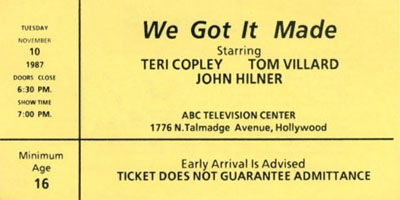
We Got It Made was a situation comedy that ran on NBC from September 8, 1983 until the following March. At first, sufficient audiences tuned in to the series which was about a gorgeous woman (Teri Copley) working as a housekeeper for two single men (Tom Villard and Matt McCoy) and getting involved in their lives and love lives. After a short while, viewers began to drift away and so did the show.
Usually, that’s the end of a series like that and it’s never heard from again. But in 1987, We Got It Made came back to TV in a syndicated version. Copley and Villard returned, McCoy was replaced by John Hilner and most of the supporting cast also changed. This version didn’t click either and while it lasted out the year, that was it.
People’s Choice, The
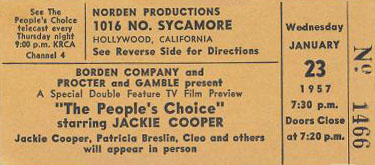
In the fifties, a lot of comedy shows filmed without a live audience, then showed the finished films to one and recorded and dubbed in that audience’s response. Usually, this was done in “preview” sessions and in order to get in audiences (and get them in the mood to laugh), the stars of the show would usually put in an appearance. Often, the screenings would be part of a whole show with comedians and there would be refreshments and prizes, as well.
The ticket is for a two-episode preview screening of The People’s Choice, a situation comedy starring Jackie Cooper that aired on NBC for three seasons, starting on October 6, 1955 and ending on September 25, 1958. It was thereafter quite popular in syndication for a time. The show was created by Irving Brecher, the writer who was responsible for The Life of Riley, the screenplay for Bye Bye Birdie, the screenplays for two Marx Brothers movies and many other successful enterprises. Jackie Cooper played Socrates “Sock” Miller, an ornithologist who’s dating the daughter of the Mayor of his city and who gets involved in the town’s politics, getting elected to its City Council. The show was stolen though by Cleo, a basset hound who would comment on the proceedings from time to time. The folks in the show couldn’t hear her but we at home could hear her thoughts which were provided by actress Mary Jane Croft. Cleo was such an important part of the show that as you can see, they promised she’d even be at the preview screenings.
1016 N. Sycamore was the address of General Services Studio, a rental facility in Hollywood where an awful lot of situation comedies filmed.
Larry Sanders Show, The
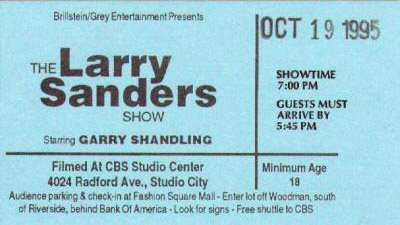
Folks who went to see The Larry Sanders Show tape only got to see portions of each episode. The innovative, widely-acclaimed situation comedy ran on HBO from August of 1992 to May of 1998. Chronicling the life and backstage dealings of a neurotic talk show host (and often employing anecdotes from backstage at real, contemporary talk shows), the series was shot on both film and tape. It was tape when we the audience were watching moments from the show that Larry Sanders starred in for an entity referred to only as “The Network.” It was film when we saw the things the viewers of that show did not see. Tapings, which sometimes involved shooting the tape segments for several episodes, were popular…and attendees said they were a lot of fun even if one only got to see about 20 minutes of taping. The lines between reality and acting were often blurred, both on the series and at these tapings.
Three Times Daley
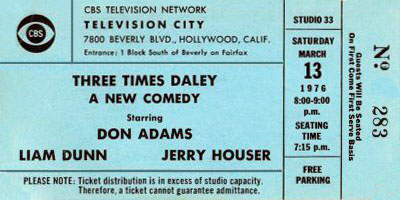
Three Times Daley was an unsold 1976 pilot created, written and produced by a fine creative talent named John Rappaport who had been one of the main folks behind the M*A*S*H TV series. It was about a home with three generations of males trying to live together: Grandfather, father and son. Don Adams played the father but the proceedings were stolen by a great character actor, Liam Dunn, playing Grandpa. I remember watching it when it aired and finding it very fresh and very funny. When I met John, I asked him why it didn’t sell. He told me he had no idea. That’s how it goes in television…too many times.
Brothers, The

The Brothers was one of the 87,000 TV series Gale Gordon appeared on…but really the only one that had him as the lead. It was created when Our Miss Brooks went off and someone at Desilu (probable Desi or Lu) realized that Gordon would be at liberty. So they paired him up with Bob Sweeney, who had previously been in a comedy team with Hal March, and Gordon and Sweeney played two bachelor brothers who operated a photography studio and shared an apartment in San Francisco. Gordon was Harvey Box. Sweeney was Gilmore “Gilly” Box and they kept getting mixed up in each other’s problems and those of their father, played at first by Frank Orth and later by Howard McNear.
Unlike most shows with Gale Gordon on them, this one didn’t last long. It went on the air on October 20, 1956 and went off on September 7 the following year. Gordon went on to other shows. Sweeney segued from performing to directing and was quite successful at it. The show also featured Barbara Billingsley as Gordon’s lady friend. When it was cancelled, she went right over to a fruitful job as the mother on Leave it to Beaver.
Barney Miller
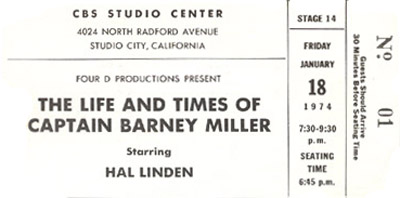
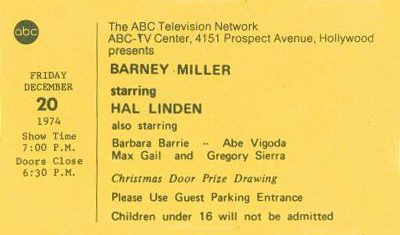
Barney Miller was a popular situation comedy which ran on ABC from January 23, 1975 to May 20, 1982. It starred Hal Linden as the Captain of the 12 precinct of the New York Police Department. Also in the cast were Max Gail, Ron Carey, Abe Vigoda, Ron Glass, Steve Landesberg, Jack Soo, James Gregory and Gregory Sierra. Some of those actors came and went (Vigoda left to star in a spin-off, Fish) and one died (Soo, during Season 5).
Abby Dalton played Miller’s wife in the pilot — taped at CBS and called The Life and Times of Captain Barney Miller — which also included Linden and Vigoda. ABC did not like the end product and the result was played off among other unsold pilots in the Summer of ’74. But in the meantime, creators Danny Arnold and Theodore Flicker had reconfigured the show and shot another pilot which ABC picked up for mid-season status. The second ticket above is from a taping done more than a month before the show debuted. The new version featured Barbara Barrie as Miller’s wife but the producers soon decided that the show should be about the Captain’s job, not his home life, and Barrie’s character wound up getting mentioned often but was rarely seen.
Barney Miller tapings were notorious throughout the industry for their marathon hours. It was not uncommon for the evening taping to be followed by a complete rewrite of the script. The audience would depart and the writers would go to work with producer Danny Arnold supervising or doing most of the heavy lifting. Retaping would eventually commence and could easily last until 1 or 2 AM. There were nights when it did not conclude until much later, with some tapings reportedly stretching until dawn. Needless to say, some episodes as aired contained nothing that had been taped before the live audience and were sweetened with canned laughter. But the show was successful and received multiple Emmys, Golden Globes and even a Peabody, so most involved seemed to think it was all worth it.
Piper’s Pets

Aaron Ruben, who was one of the main creative forces behind The Andy Griffith Show and CPO Sharkey, took a star from each and concocted Piper’s Pets — an unsold pilot. It starred Don Knotts as Dr. Donald Piper, a small town veterinarian and Peter Isacksen as his well-meaning but perpetually confused assistant, Lester. Maggie Roswell played Dr. Piper’s wife and Jacque Lynn Colton played his receptionist. NBC had it in mind as a possible mid-season replacement (which explains why it taped in September) but somehow, they felt the chemistry just wasn’t there.
CPO Sharkey

Johnny Carson used to joke that Don Rickles had had his finger in more pilots than an Air Force Proctologist. There was a time there when Rickles was appearing in an amazing array of unsold pilots and even a few that made it to series and didn’t last long. His longest run — it actually lasted a year and a half — was with CPO Sharkey, a sitcom that attempted to turn the insult comic into a latter-day Sgt. Bilko. In fact, the series was even created and masterminded by Aaron Ruben, who’d worked extensively on You’ll Never Get Rich (AKA The Phil Silvers Show, AKA Sgt. Bilko).
“CPO” stood for Chief Petty Officer. Sharkey presided over a mixed ethnic group of sailors, each of whom he derided in the Rickles style. Many of his insults were saved for Seaman Pruitt, a 6’7″ hick played by Peter Isacksen. Rickles was 5’6″ and so delivered a lot of acidic lines to Isacksen’s chest.
The show lasted 37 episodes and the above ticket was probably for one of the last ones taped. They were all done on Stage 3 at NBC, which is where Jay Leno now does his show. This is directly across the hall from Stage 1 where Johnny Carson did The Tonight Show for so many years. One of the few reasons CPO Sharkey is remembered is because of one night when Carson — allegedly spontaneously but probably planned in detail — took his cameras across the hall and interrupted a Rickles taping. The night before on Tonight, appearing with guest host Bob Newhart, Rickles had accidentally broken Carson’s cigarette box. So right in the middle of taping a scene, Don looks over and there’s Johnny Carson, walking in with a hand microphone and a busted cigarette box to demand an apology. It was very funny and the incident bolstered the ratings of CPO Sharkey…for a while. Like all TV shows starring Don Rickles, it didn’t last long.
Phyllis
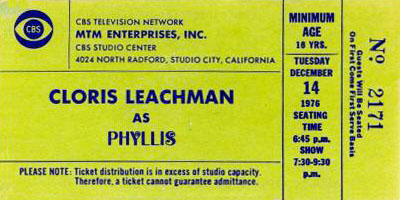
Rhoda got a spin-off series from The Mary Tyler Moore Show so why not Phyllis? Rhoda started in ’74 and Phyllis, starring Cloris Leachman, debuted on September 11, 1975.
The premise: Her husband Lars had died. She and her daughter Bess (played by Lisa Gerritsen) moved from Minneapolis to her old home town of San Francisco, where his mother (played by Jane Rose) and stepfather (played by Henry Jones) still resided. Beyond that, the supporting cast changed from time to time as the writers struggled to find the kind of “family” that was the norm in sitcoms from the MTM Company. They never quite made it. Even with occasional cameos from the old Mary Tyler Moore Show cast, Phyllis only lasted two seasons…and probably would have run one, had it not come with such a promising pedigree.
My favorite moment in the series occurred in the first series when the cast included Richard Schaal, playing a guy who wasn’t the brightest of bulbs. In one episode, Bess was dating (and talking about marriage to) a boy of normal height but whose parents were played by well-known “little people” Billy Barty and Patti Maloney. Phyllis was creeped-out at the genetic possibilities if Bess and the lad married and had children and was acting more nervous than usual. Schaal’s character asked her what was wrong. She replied, “Bess wants to marry a boy whose parents are midgets!”
Schaal responded, “Well, I hope she finds one.” Big laugh.
Cloris/Phyllis said, “No, no. Bess is dating a boy whose parents are midgets!”
Schaal: “Well then, there’s no problem!” Even bigger laugh. If they’d had more like that, the show might have lasted longer.
Here’s Lucy
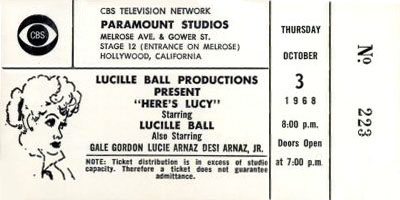

Lucille Ball’s third sitcom, Here’s Lucy, debuted on September 23, 1968, a full six months after her previous series, The Lucy Show, had left the network. One might wonder why the change since her new character, Lucy Carter, wasn’t all that different from her character on The Lucy Show, Lucy Carmichael, and both had Gale Gordon playing the “foil” in her life. Mr. Gordon’s character didn’t change a lot, either, nor did the show’s Monday night time slot. Depending on who you asked, you could get any number of reasons for the conversion…
The old format was tired. After 156 episodes, Lucy needed some sort of change in her show, however minor.
Lucy wanted to work with her kids, Lucie and Desi Jr. Rather than find an awkward way to insert those characters into the life of Lucy Carmichael (which would mean they would not play her children), it was easier to change Lucy to Lucy Carter and just make them that character’s offspring.
Starting a new show would mean that the old show would be freed up for unrestricted syndication and money could be made off those 156 episodes.
Lucy had owned The Lucy Show by virtue of her ownership of Desilu Studios, the company that produced it. In 1967, she sold Desilu to Gulf+Western, the conglomerate which the year before had acquired Paramount Pictures. Lucy didn’t want to keep doing a TV show in which she had no ownership position so she ended The Lucy Show and started a new show which could be owned by her new company, which was co-owned by Gary Morton. Here’s Lucy was produced by Lucille Ball Productions.
And there may have been other reasons as well, but all of the above were probably valid to some extent. How was the new show? About the same as the old show. It had memorable times, like the 1970 episode which guested Elizabeth Taylor and Richard Burton. It had poorer moments, like most of the 1972-1973 season wherein Lucy Carter was in a wheelchair owing to the real Lucy’s leg fracture from a skiing accident. Ms. Ball’s physical comedy was scaled back after that, even after the cast was removed. (They probably would have had to do that even if she hadn’t fractured her leg. Lucy was 61 years old in 1972, a bit aged to be doing some of the things she’d been doing…including skiing when she wasn’t performing.)
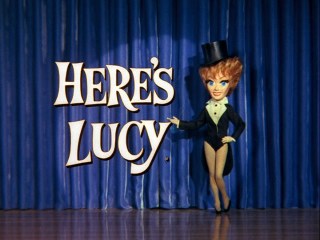
Even though Lucy no longer owned the place, Here’s Lucy filmed on the Paramount lot, and the filmings were said to be a love fest to her, with Lucy-loving audiences. Gary Morton often did the warm-ups and gave her the full star treatment, and guest stars abounded. All of Lucy’s old pals — Jack Benny, George Burns, Milton Berle, Phil Silvers, Carol Burnett, et al (even Vivian Vance) — dropped by one or more times. In addition to her kids and Gordon, she was joined in the cast by Mary Jane Croft, who filled Vance’s old function of playing Lucy’s best friend.
The show had good ratings throughout its run and its cancellation (the last one aired March 18, 1974) was met with some controversy. Prime-time TV, especially on CBS, had changed with the coming of shows like All in the Family, M*A*S*H and The Mary Tyler Moore Show, and others that were believed to attract a younger, hipper viewership. Lucy’s act, which hadn’t changed much since the days of I Love Lucy, didn’t seem to fit in. Her “retirement” from weekly television after nearly 23 years was announced as her idea but it was rumored that CBS had the idea first, and that an attempt to place the series with another network had failed. Lucy went on to do guest appearances and specials and even made one return to the world of the weekly sitcom — Life With Lucy in 1986.






